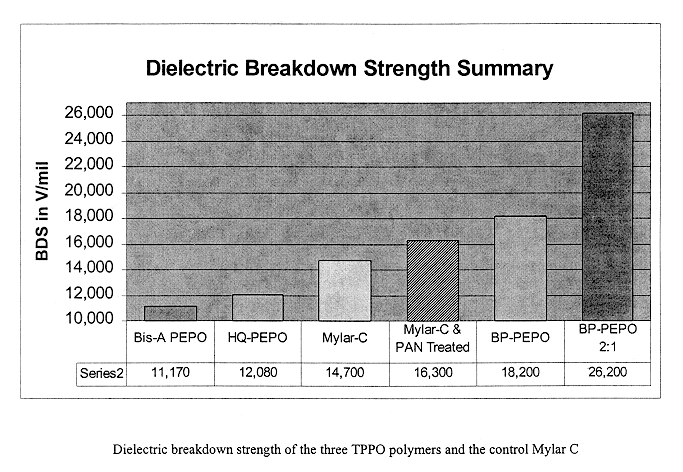Triphenyl phosphine oxide polymer capacitors
a polymer capacitor and triphenyl phosphine oxide technology, applied in the direction of capacitors, fixed capacitor details, multiple fixed capacitors, etc., can solve the problems of small dielectric constant, film forming difficulty, and great decrease in dielectric properties in humid atmospher
- Summary
- Abstract
- Description
- Claims
- Application Information
AI Technical Summary
Problems solved by technology
Method used
Image
Examples
example 1
Dielectric testing
Dielectric testing was performed on the three TPPO polymers synthesized and prepared as described above. The dielectric constant was calculated using the measured values of capacitance (C), thickness (T) and electrode area (A) and by applying the following classic equation for capacitance:
C=-.sub.o.kappa..sub.d (A / T), where -.sub.o =8.854.times.10.sup.-12 f / m
Solving for K.sub.d gives; .kappa..sub.d =(C T) / (-.sub.o A)
A precision micrometer was used to determine the thickness. The electrode diameter was measured using a hand held micrometer. All capacitance and dissipation measurements were performed using a Stanford Research Systems LCR meter (model SR715).
The characterization of these films consists of measuring dielectric constant (k is calculated from thickness and capacitance), and dissipation factor (DF) at several frequencies (120 Hz, 1 kHz, and 10 kHz). The dielectric constant and DF was characterized for all three films and the Mylar-C control films at room ...
example 2
Breakdown Strength Measurement Results
A high voltage breakdown testing apparatus consisted of a polycarbonate test cell, High Voltage DC power supply, chart recorder, and a digital voltmeter with voltage divider for monitoring the test conditions, as specified under ASTM D149. The test cells were designed for testing metallized and plain films. The apparatus was tested using Mylar-C film ranging from 0.06 mil to 1.00 mill thickness and with complete dielectric properties data. These films were also used for the conducting polymer electrode experiments. The trials with the Mylar films consistently reproduced the results documented in the data sheets.
Breakdown testing is a bulk material property that is dependent on test apparatus and conditions like humidity. Therefore, breakdown testing was performed in series on the same day,for all samples and control samples, to reduce day to day variability.
Capacitors were fabricated from both the "as delivered" Mylar-C films and those specially...
PUM
 Login to View More
Login to View More Abstract
Description
Claims
Application Information
 Login to View More
Login to View More - R&D
- Intellectual Property
- Life Sciences
- Materials
- Tech Scout
- Unparalleled Data Quality
- Higher Quality Content
- 60% Fewer Hallucinations
Browse by: Latest US Patents, China's latest patents, Technical Efficacy Thesaurus, Application Domain, Technology Topic, Popular Technical Reports.
© 2025 PatSnap. All rights reserved.Legal|Privacy policy|Modern Slavery Act Transparency Statement|Sitemap|About US| Contact US: help@patsnap.com

